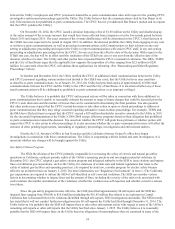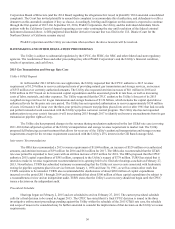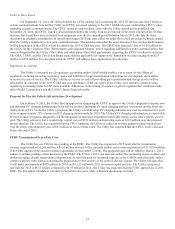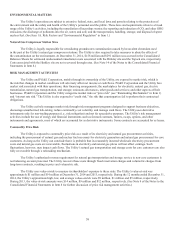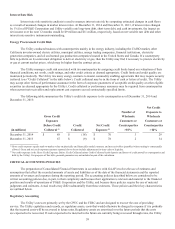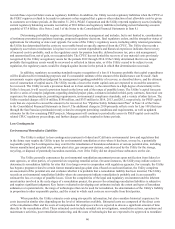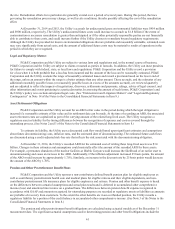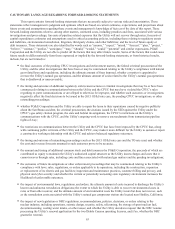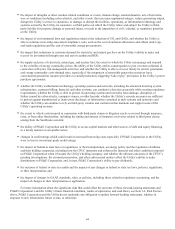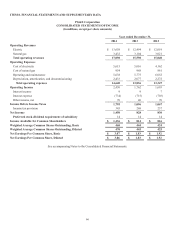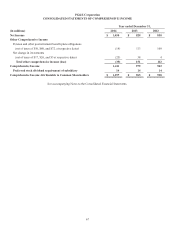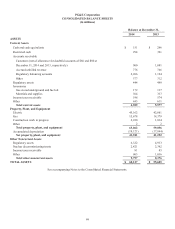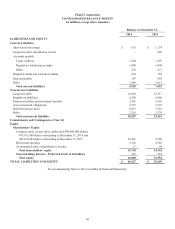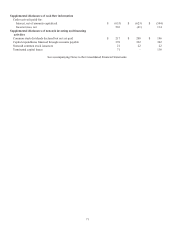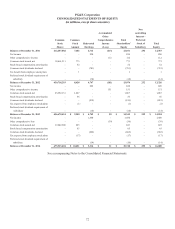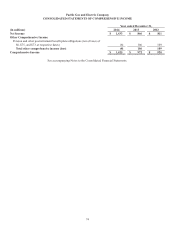PG&E 2014 Annual Report Download - page 72
Download and view the complete annual report
Please find page 72 of the 2014 PG&E annual report below. You can navigate through the pages in the report by either clicking on the pages listed below, or by using the keyword search tool below to find specific information within the annual report.64
the impact of droughts or other weather-related conditions or events, climate change, natural disasters, acts of terrorism,
war, or vandalism (including cyber-attacks), and other events, that can cause unplanned outages, reduce generating output,
disrupt the Utility’s service to customers, or damage or disrupt the facilities, operations, or information technology and
systems owned by the Utility, its customers, or third parties on which the Utility relies; and subject the Utility to third-
party liability for property damage or personal injury, or result in the imposition of civil, criminal, or regulatory penalties
on the Utility;
the impact of environmental laws and regulations aimed at the reduction of CO2 and GHGs, and whether the Utility is
able to continue recovering associated compliance costs, such as the cost of emission allowances and offsets under cap-
and-trade regulations and the cost of renewable energy procurement;
the impact that reductions in customer demand for electricity and natural gas have on the Utility’s ability to make and
recover its investments through rates and earn its authorized ROE;
the supply and price of electricity, natural gas, and nuclear fuel; the extent to which the Utility can manage and respond
to the volatility of energy commodity prices; the ability of the Utility and its counterparties to post or return collateral in
connection with price risk management activities; and whether the Utility is able to recover timely its electric generation
and energy commodity costs through rates, especially if the integration of renewable generation resources force
conventional generation resource providers to curtail production, triggering “take or pay” provisions in the Utility’s power
purchase agreements;
whether the Utility’s information technology, operating systems and networks, including the advanced metering system
infrastructure, customer billing, nancial, and other systems, can continue to function accurately while meeting regulatory
requirements; whether the Utility is able to protect its operating systems and networks from damage, disruption, or
failure caused by cyber-attacks, computer viruses, or other hazards; whether the Utility’s security measures are sufcient
to protect against unauthorized or inadvertent disclosure of information contained in such systems and networks; and
whether the Utility can continue to rely on third-party vendors and contractors that maintain and support some of the
Utility’s operating systems;
the extent to which costs incurred in connection with third-party claims or litigation can be recovered through insurance,
rates, or from other third parties; including the timing and amount of insurance recoveries related to third party claims
arising from the San Bruno accident;
the ability of PG&E Corporation and the Utility to access capital markets and other sources of debt and equity nancing
in a timely manner on acceptable terms;
changes in credit ratings which could result in increased borrowing costs especially if PG&E Corporation or the Utility
were to lose its investment grade credit ratings;
the impact of federal or state laws or regulations, or their interpretation, on energy policy and the regulation of utilities
and their holding companies, including how the CPUC interprets and enforces the nancial and other conditions imposed
on PG&E Corporation when it became the Utility’s holding company, and whether the ultimate outcomes of the CPUC’s
pending investigations, the criminal prosecution, and other enforcement matters affect the Utility’s ability to make
distributions to PG&E Corporation, and, in turn, PG&E Corporation’s ability to pay dividends;
the outcome of federal or state tax audits and the impact of any changes in federal or state tax laws, policies, regulations,
or their interpretation; and
the impact of changes in GAAP, standards, rules, or policies, including those related to regulatory accounting, and the
impact of changes in their interpretation or application.
For more information about the significant risks that could affect the outcome of these forward-looking statements and
PG&E Corporation’s and the Utility’s future financial condition, results of operations, and cash flows, see Item 1A. Risk Factors
above. PG&E Corporation and the Utility do not undertake any obligation to update forward-looking statements, whether in
response to new information, future events, or otherwise.


